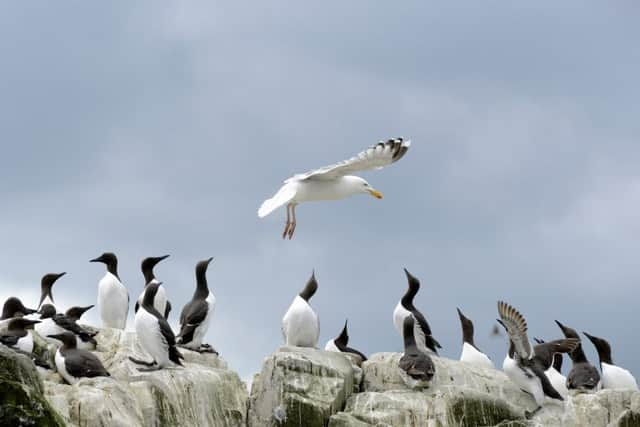Northumberland, Bird Club


Deputy chairman Stewart McCormick warmly welcomed Mark Holling, Former President of the Scottish Ornithological Club and Secretary of the Rare Birds Breeding Panel to north Northumberland Bird Club.
His talk was entitled ‘Twenty Years On: The South- East Scotland Bird Atlas’ reflecting on his involvement with the first ever Bird Atlas for Lothian and the Borders 20 years ago and his current work on the new Bird Atlas, which will update and greatly expand the data.
Advertisement
Hide AdAdvertisement
Hide AdThe first atlas produced for SE Scotland (1988-94) drew on the BTO 1981-84 Atlas. Whereas Mark and his 10 colleagues did not have the vast resources of the BTO to hand, they did have expertise and local knowledge. The new local Atlas, like its predecessor, bases its methodology on that of the BTO (British Trust for Ornithology) Atlases, particularly the most recent BTO publication published in 2013, which combined both breeding and wintering birds in one volume.
This mighty tome mapped such information as breeding evidence, range, abundance, change and distribution of species.
The new local Atlas (2007-13) is based on data collected from 1770 ‘tetrads’(2km x2km squares), the area covered being the Lothian and Borders region, encompassing the Cheviots, the Moorfoot Hills, the Pentland Hills and the Lammermuirs.
Whilst advances in mapping through aerial surveys and satellite technology have revolutionised our understanding of habitat and terrain, the gathering of information on bird species and their abundance is still very labour intensive, requiring many volunteer birders on the ground. It took six years of fieldwork ( a staggering 13,852 hours) from 827 observers to gather the 456,808 records, which form the basis of this new study, a triumph of ‘Citizen Science’.
Advertisement
Hide AdAdvertisement
Hide AdThe habitats studied included everything from grasslands, river valleys, arable farmland, coniferous and deciduous woodlands, heather moors and the coastal environment to urban areas such as West Lothian and the city of Edinburgh. By overlaying the habitat maps with the abundance or scarcity of each species in each tetrad, a simple but clear correlation emerges of the birds most likely to inhabit these areas, eg Yellowhammers/arable land, Crossbills/ coniferous forests, Long-tailed Tits/ deciduous woods, Red Grouse/quality heather moorland, Dippers and Goosanders along river valleys, graphically illustrating the relationship between birds and habitat. Graphs further help to explain the correlation between altitude and species richness; it can clearly be seen on an altitude graph, overlaid with a Tree Pipit graph, for example, that this species is most abundant at between 100-450 metres (and never above 500 metres where there are no trees).
Comparing the original 1988-94 Atlas with the current one, there are clearly winners and losers. Among the former is the Great Spotted Woodpecker, now found in most tetrads and occurring at higher altitudes than previously. Nuthatch is another of the 54 species which has increased; first creeping over the Border to breed as recently 1988/9 it now occupies 458 tetrads, possibly due to warmer winters and the increased food source from garden feeders. Ospreys were non-breeders here 40 years ago, but now they nest in several areas. Other species increasing include Greylag Goose, Buzzard, Jay, Lesser Black-backed Gull, Sand Martin, Raven, Blackcap and Chiffchaff, this latter species moving north in response to climate change. Stonechat has also increased, although the very severe winter of 2010 saw a dramatic reverse in numbers. Barn Owls also suffer in severe winters or cold springs, but are generally increasing helped by nest box provision.
Seabirds form an important component of the area’s Avifauna due to its extensive coastline, including the Forth islands and the Bass Rock. Seabird numbers have remained fairly stable since the previous Atlas with some declines in Kittiwake, Shag and Herring Gull, but Gannets have increased massively from 39,800-75,300 to the point where they have been seen displaying around St Abbs Headland-the Bass Rock having no more room!
Ninety species have recorded losses including Pied Flycatcher, Wood Warbler, Marsh Tit and Corn Bunting. The decline in Kestrel numbers remains a puzzle. One study of Coot showed huge increase in the mid-1990s followed by a decrease around 2000 from which they have not recovered. Tufted Duck and Black-headed Gull showed similar decline. The resurgence of the Otter in the region has been suggested as a possible cause. Oystercatcher apart, most waders such as Redshank, Woodcock, Snipe and Golden Plover have declined in numbers as have Ringed Plover.
Advertisement
Hide AdAdvertisement
Hide AdIn conclusion, Mark emphasised that there are always winners and losers, with waders, waterfowl, and woodland bird numbers falling, possibly due to habitat change, loss of food and overgrazing whilst the winners benefit from warmer winters, and availability of more food due to human activity. Birds in South East Scotland 2007-2013, covering 150 species in depth, will be published later this year and will be available in book or DVD format.
Our next indoor meeting, following the summer break, will be held as usual in Bamburgh Pavilion on Friday, September 16, when Tim Dean will present an illustrated talk on The Birds of Peru.